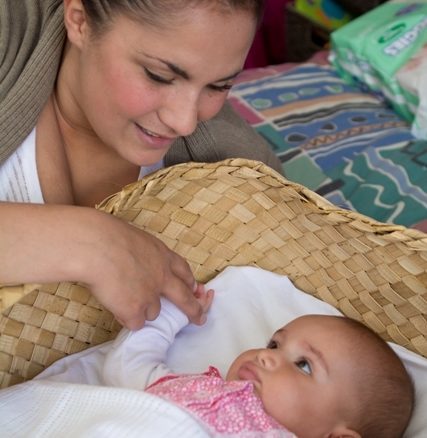Baby sleep is often a controversial topic. New parents, whether breastfeeding or bottle-feeding, are usually sleep deprived due to numerous and expected baby waking up periods during the night. It’s important to talk about concerns with your midwife or well child nurse as parents may feel there is something ‘wrong’ with a wakeful baby, particularly if they have come across misleading information about sleep training or articles containing unrealistic expectations about baby behaviour. It is also important for exhausted parents to have support about how to manage during this time of sleep deprivation and broken sleep.
It is recommended that babies sleep in the same room as their parents until at least the age of six months as a protection against sudden unexpected death in infancy (SUDI). Some parents settle babies in their own bassinet or cot and others make a decision to share their bed with their baby. There are safe sleeping tools available for parents – pepi pods or wahakura.
Avoid having a baby in bed if the baby:
- has been exposed to any smoking in pregnancy or postnatally
- is premature or of low birthweight
- is formula fed
- is unwell
Face-up + face clear + smokefree. Face-up position protects arousal in babies during a critical stage of development, Face clear protects from asphyxia in the sleeping environment, Smokefree reduces vulnerability.
Health Navigator has useful information about how to share a bed safely with a baby and how to reduce the risks of SUDI, and this includes advice to create a smoke-free environment and to breastfeed.
It is important that every baby sleep is a safe sleep whether during the day or night, at home or out of the home. One of the most dangerous places for a baby to sleep, either alone or with someone, is a sofa, so it is better for a tired mother, who thinks she may easily fall asleep, to breastfeed her baby in bed rather than getting up to breastfeed on a sofa.
Here is information from ‘The Baby Sleep Info Source’ (BASIS) about the dangers of sofa-sharing.
Access to information about what is biologically normal sleep for babies can help parents understand how to navigate the mass of different information out there on the internet and from families and friends, and how to separate evidence from opinions. The Baby Sleep Info Source (BASIS) is a good resource for evidence about normal sleep development and how babies operate in tune with their own internal biological rhythms
